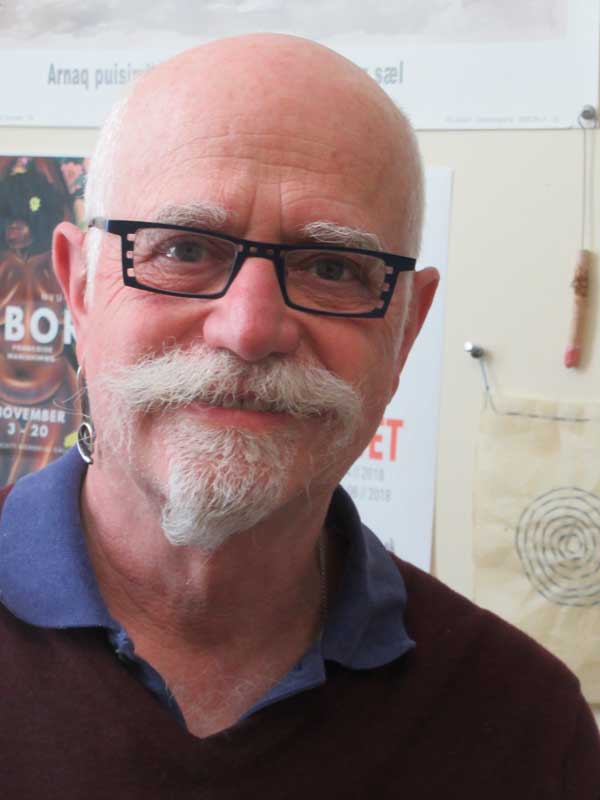Ken Leslie ponders the exit ramp
Professor of Fine Arts Ken Leslie
Despite his retirement looming in May, Ken Leslie’s office is as busy as ever. NVU’s Professor of Fine Arts since 1984 still has work to do before the curtains close on his 38-year stint at Johnson in just a few months.
Art supplies lie in various stacks about his desk and the calculated clutter extends to the walls and the floor in the local legend’s small office. Photographs and paintings cover most of vertical surfaces in the small room and one can’t help but feel that Leslie has more than once considered blocking off his large window to make room for more pieces to hang and admire.
His bookshelf is loaded with a personal collection of books on art and painting that he has loaned out to students on countless occasions. After moving a small pile of papers, he takes great pride in showing me the single empty shelf that he has managed to pack away in anticipation of his grand transition. Forever a teacher, he can’t resist the opportunity to point out that the stack he is moving is carbon transfer paper and manages to give me a brief and informative history lesson in just under sixty seconds.
His enthusiasm is impossible to ignore and makes carbon transfer paper not just interesting, but exciting.
“I started teaching when there was a switchboard operator and no computers; it’s very different than it is now,” says Leslie. “I think I have changed, too. People who know me might not believe this, but I used to be even meaner. I used to be even less patient and so forth. I’m much more able to roll with whatever it is now. I’ve definitely grown that way. I think I’ve gotten better at paying more attention to what the students might be trying to do and have helped them get there. Maybe I’m deluding myself about that, but I don’t think so.”
Turning 70 in just a few months, Leslie began his career at Johnson at the age of 32. With lots of experiences behind him, he now gets to look ahead unencumbered. “I have always been an artist myself,” he says. “I have a studio that I work on all kinds of projects in. I have many years of work in different communities in Greenland and I would love to be able to go back there, but right now all that’s on hold because of COVID. So, a whole lot of art projects to get at and begin to garden and eating and cooking and a whole lot of things like that. I am not retiring into nothing and just leaving this behind, there is plenty still to be done.”
Leslie is very aware of the technological changes that have altered the way he works since staring this job 38 years ago. “With the advent of email, it is much harder to be ‘off’ than it used to be,” he says. “It feels more like a 24/7 thing. Sorry if I sound like an old fart complaining about that. But I worry about the effect that has on people in the sense of private time and the sense of time off and rejuvenation of weekends. I’m looking forward to not checking my email every day.”
The biggest question retirees are asked is, ‘what’s next?’ Leslie, being the creative individual that he is, has plenty of projects to keep him occupied for the time being. “I’ve been rebuilding my studio a bit to make it a little bit better for full-time occupation,” he said.
Leslie has no shortage of projects to take on once the spring semester closes. He gives some details about working on a variety of projects and even speaks of a large circular frame that is being built on which for him to paint another ambitious project. “I would like to do some work that betters the world somehow,” he said.
Looking forward to retirement doesn’t come without the bittersweet memories of a long and fruitful career in education. “I’m definitely going to miss the regular interaction with creative people and students,” says Leslie. “It’s at least half about the art, but it’s also just about dealing with life, and I enjoy helping people figure that out, or at least not making it worse, right?”
NVU Professor of Art History Mary Martin has worked with Ken Leslie for years and credits him with many of the innovations the department has experienced over decades.
“I cannot emphasize enough how much Ken has impacted the art program,” said Martin. “When Ken began teaching in 1984, the art program did not even have a building. Over Ken’s career, we have seen the creation of the art building and then the expansion of the art building in 2012. Ken also co-created the MFA program and oversaw the initial collaboration with the Vermont Woodworking School, which has led to our degrees in woodworking and fine furniture design. We have a vibrant arts community due to Ken’s leadership, hard work, and determination. What I will miss the most, though, is his sense of humor and positive outlook. Ken has provided us all with an atmosphere of community and collaboration where everyone feels respected and admired.”
Leslie has seen many changes over the nearly 40 years he has been in the art department, both in the scope of the programs and in the colleagues surrounding him.
“I believe the art program here at Johnson, in general, was a bit of a disaster when I first got here,” Leslie said. “Now, I’m not saying it was I who fixed it. It was a whole lot of really good work done by a whole lot of people that got it to a really great place. I’ve been really lucky, especially for the last two thirds of my time here, having wonderful colleagues. We get along really well in this building and beyond. That’s been really wonderful. I’ll miss that and I intend to keep these relationships going, but I also know that doesn’t always happen.”
The prolific painter will leave more than an emotional mark on campus; his two large paintings in the 24-hour study hall at the Willey Library will continue to be admired by students on campus for years to come.
Many past and present students from the Johnson campus, myself included, possess paintings that would simply not exist without the instruction and encouragement of Leslie.
These pieces are often painted upon canvases that have been hand stretched by students under his supervision, and he is always eager to assist with the staple gun or do some stretching of his own with decades of practiced skill, a skill he has passed on to hundreds of students.
“Ken is a total leader, and he helped guide me through my BFA and pushed me to go beyond my everyday comfort zone,” said Amanda Farrell (Hallock), who graduated from Johnson State College in 2007 and now owns and operates Bergamot + Amor. “He wasn’t afraid to be a hard-ass or call me out for my work lacking depth. That’s something I’ll always carry with me throughout my career. Where most professors were just happy that I completed the assignment, Ken always questioned my approach, execution, and plans. He drilled me with questions that tore into the fibers of everything I’d done and inspired me to push deeper. Whatever I’m making, to this day, I always step back and give my work the good ol’ Ken Leslie critique. His grit was admirable, and his work spoke for his level of genuine genius. He was undoubtedly one of a kind.”
Professor of Writing and Literature Tyrone Shaw teamed up with Leslie a decade ago to create a multi-media travel course focused on the art and culture of Cuba. “My experiences with Ken have been an absolute pleasure, from the initial design process of this remarkable experiential class to the immersive time in Cuba with sixteen students,” says Shaw. “We’ve run four of these three-credit trips since 2013, and they’ve kept getting better. I can think of no more delightful travel companion. Ken is like a joyous pied-piper on these trips, as I suspect he is on all of his travel classes. He has a way of conveying his appreciation and knowledge that is nothing short of magical.”
Shaw said Leslie will be hard to replace, and certainly impossible to replicate.
“He exemplifies the best of what Johnson has been and what I hope we continue to be,” says Shaw. “I’ll miss him for a number of reasons. He’s been a wise and supportive mentor for me during my 30 years here. I know he has inspired legions of students to embrace the joys and frustrations of the artist’s life.”




